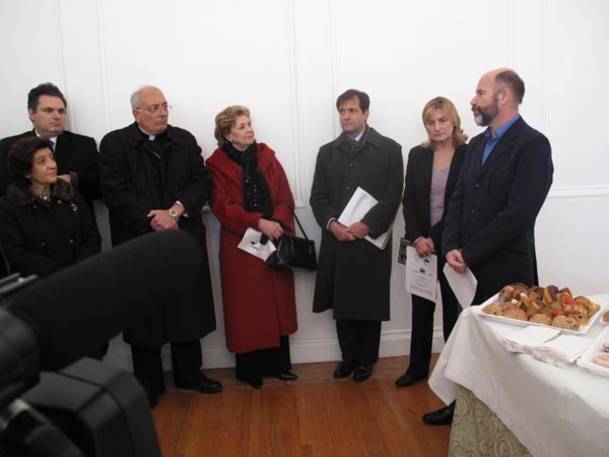


The first time tourists go to the Jewish Museum [2] in Berlin or to Yad Vashem [3] in Israel, many of them walk out shocked. They are not shocked simply by the content of the rooms, or by the subject of the Holocaust, with its loss of lives and racial ideologies, they are shocked because they don’t find what they expect from a traditional museum: they don’t just find papers behind a window case or preserved objects. Visitors walk around and all of a sudden they are in a dark corridor, with nothing but a sense of void, or they are stepping on ten thousand iron faces (Fallen Leaves, Jewish Museum of Berlin). Signs do not guide them. Instead, the museum zigzags, the hallways go in circles. Visitors are basically led to feel lost.
At Yad Vashem, the progression of the rooms is psychological, not necessarily only chronological. The visual projections, bare concrete walls, and interpretive works of art lead up to The Hall of Names: the ceiling of the Hall is composed of a ten-meter high cone reaching skywards, displaying 600 photographs, a small percentage of the murdered six million men, but a big enough number to make the visitor feel completely overwhelmed by being surrounded by all those faces.
Both museums display a lot of contemporary and post-modern artists who understand that the Holocaust is not just about memory, it is a dividing line in modern thought and psychology, and it’s an existential experience.
Jack Sal, an artist who displayed his work in an exhibit called De/Portees [4] at the Italian Cultural Institute [5] on January 27 2010, at exactly the same time of the reading of the names of the Italian Jews at the Italian Consulate, can be placed in this line of thought. The inauguration of his multi screen projection, combined with the sound of the people on Park Avenue reading aloud thousands of names, managed to recreate that same feeling of displacement and loss recreated for example by Yad Vashem.
Jack Sal is a minimalist and conceptual artist whose many installations have been seen at the MoMA, the Museum Ludwig in Koln, Museum Moderner Kunst in Vienna and many others. This specific exhibit will remain at the Italian Institute until February 26th and in Rome from April 7 to April 30 at the Casa della Memoria e della Storia. In 1993 he declared that, “The goal of the artist is to produce Aart that creates a context. Without context neither knowledge nor understanding can be reached”.
In De/Portees Jack Sal does exactly this: he recreates the context, the geographical confusion of all the places involved in the Italian Shoah. On two different screens we can see the names of those cities, towns and villages where the deportees lived and of the camps, which are not just the most infamous places like Fossoli, but little towns where camps were sometimes created and dismantled overnight.
Also, the main installation is a video, where a hand slowly flips the pages of the list of the deportees (the same names that were being read outside) with a soundtrack of a Primo Levi quote. “‘The duty of hope and the duty of not forgetting are neither synonyms nor opposites. They can coexist. All the combinations are possible: remembering and hoping, remembering and despairing, forgetting and hoping, forgetting and not hoping. My position would be to remember and to hope’”.
Both the dark room, and the repetition of the same quote over and over while the pages are turned, are very effective. The artist himself explains his exhibit: “This emphasis on physicality is important. It takes 25 minutes to turn all the pages, one by one, to go over all the names, he says, while outside, on Park Avenue, it’s taking seven hours, from 9AM to 4PM to read every single name.
It’s a physical feeling; that of not even being able to count and finding yourself thinking: “Were there really so many people?”
Jack Sal is the child of two Holocaust survivors. “My parents emigrated to the USA after they survived the war. My mom hid in the woods of Galizia”. He underlined how this for him is a personal, cultural and political experience.
The reasons that lead him to choose that specific quote of Primo Levi can be found in the interviews to Levi (M. Belpoliti and R. Gordon, 2001, The Voice of Memory: Primo Levi, Cambridge: Polity) in which Jack Sal could see Levi’s direct reflection on the topic, as he was speaking and writing irrationally. Jack Sal explained that there are various kinds of memory for Levi, which are “anger, pain, and reprisal, but his idea was to focus on hope”.
As pointed out before, the opening of this exhibit coincided with the gathering of different religious authorities (Rabbi Schneider, Cardinal Egan) the representatives of the Italian consulate, and of the most important Jewish Organizations in NYC (such as Centro Primo Levi [6]) and prominent figures such as Mrs. Matilda Cuomo, who along with other people and school children, read the lists of the deportees.
In introducing Jack Sal’s exhibit, General Consul Francesco Maria Talò said: “Art is a crucial way to pay homage, to remember”.
Some curious people stopped by and caught a name or two, snapped quick pictures, grabbed their kids by the hands and whispered something into their ears. While the cameras of various TV stations all focused on the podium in front of the Italian Cultural Institute, Jack Sal’s exhibit simultaneously occurred. Hence many names were evoked, which is so powerful since a name sometimes is all we have left of a time, place, person.
Source URL: http://test.casaitaliananyu.org/magazine/focus/art-culture/article/de-portees-artistic-conceptual-look-holocaust
Links
[1] http://test.casaitaliananyu.org/files/img75371264708003jpg
[2] http://www.jmberlin.de/
[3] http://www.yadvashem.org/
[4] http://www.jacksal.com/special_projects/italian_cultural_institute_ny.html
[5] http://www.iicnewyork.esteri.it/IIC_Newyork
[6] http://www.primolevicenter.org/Home.html